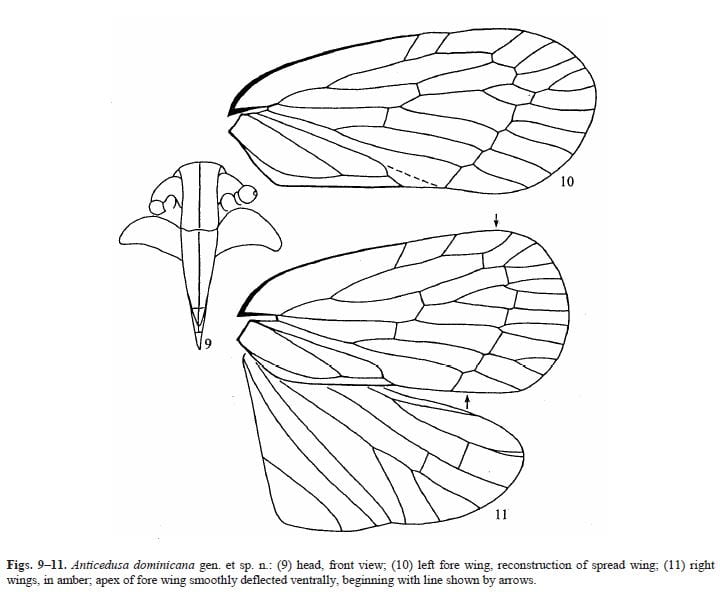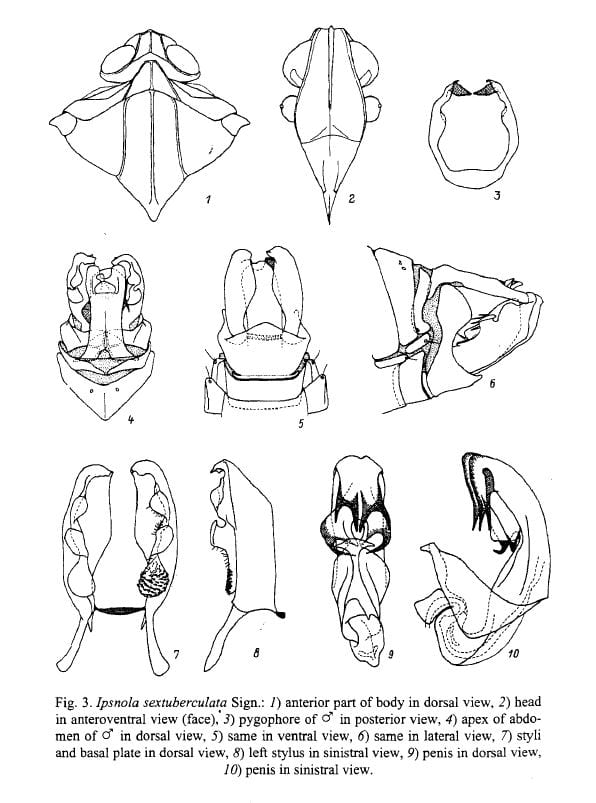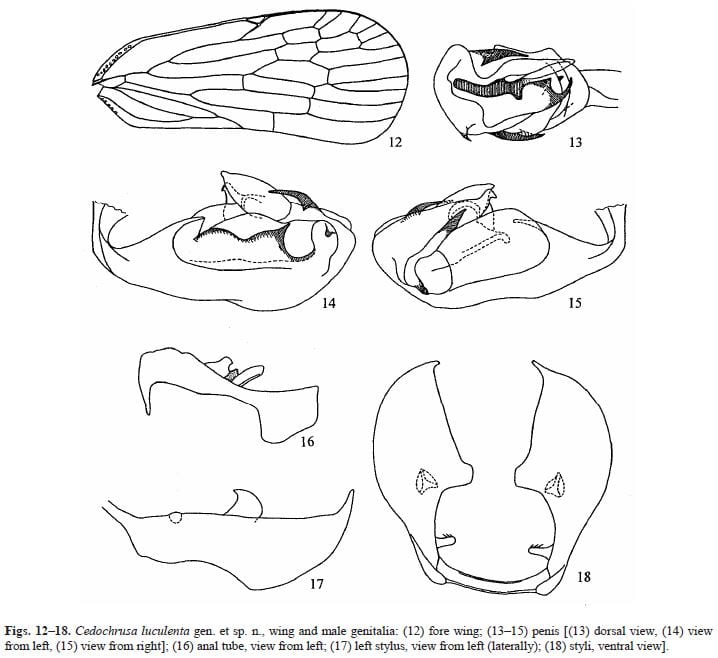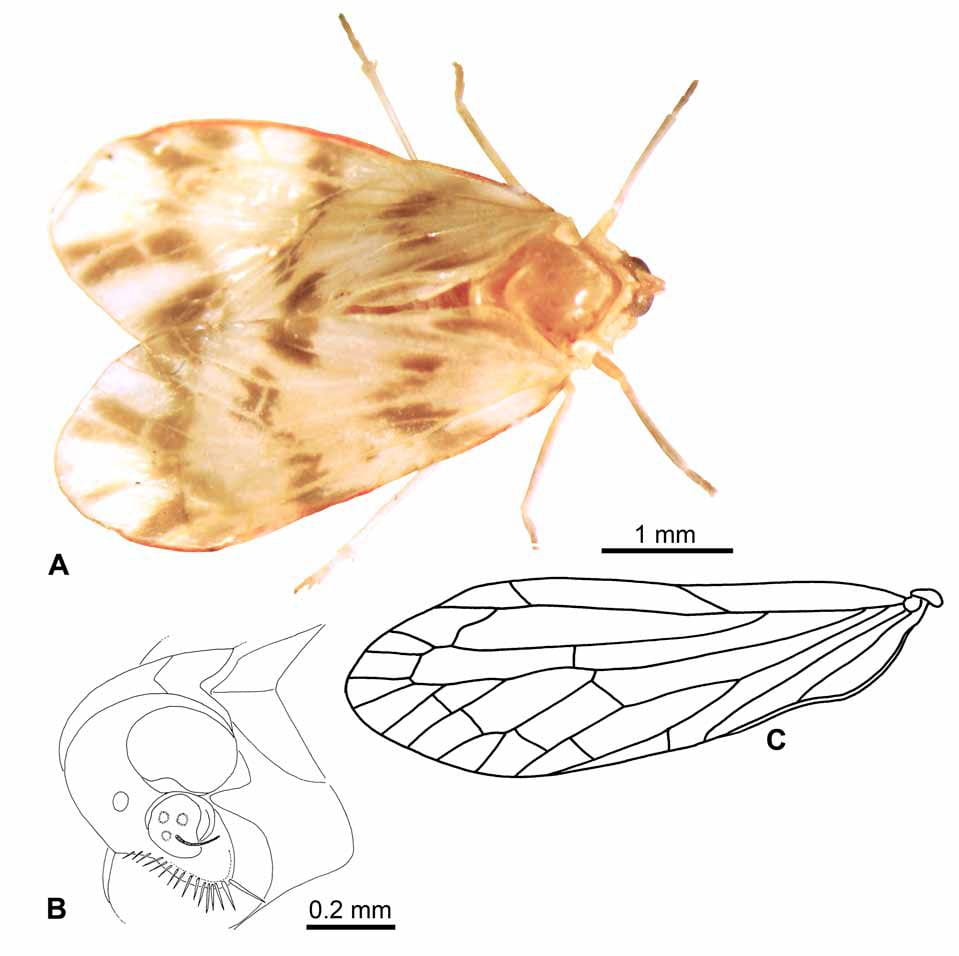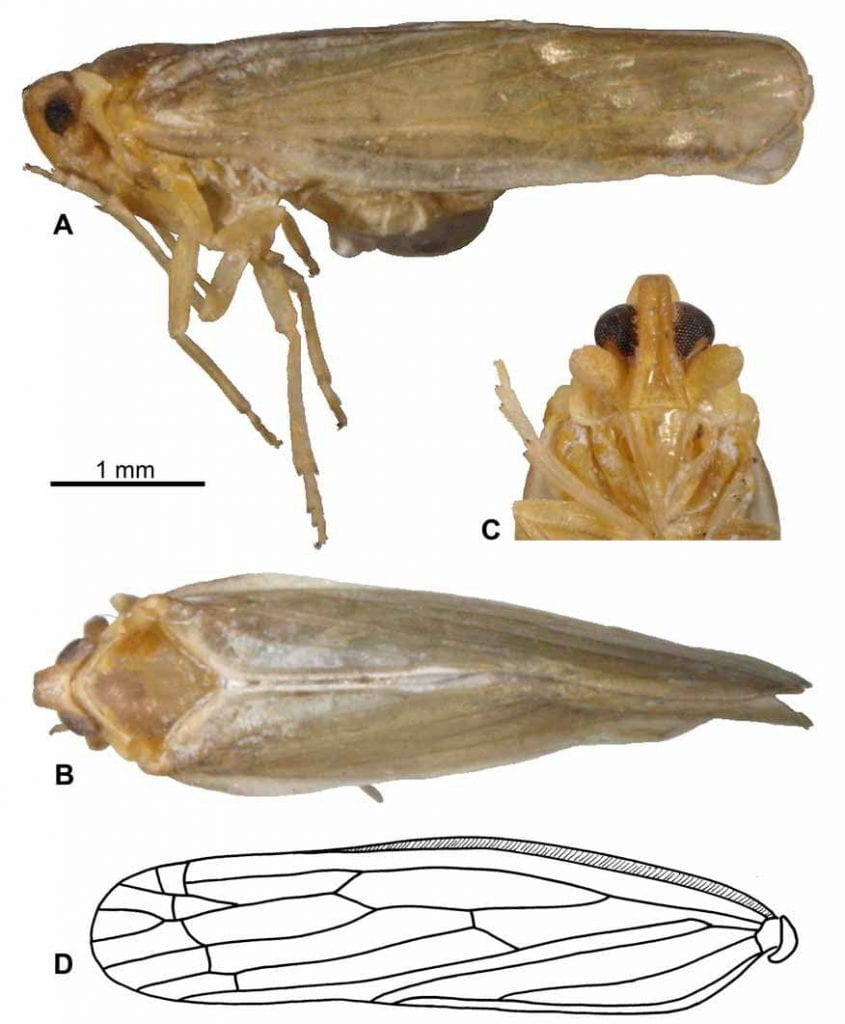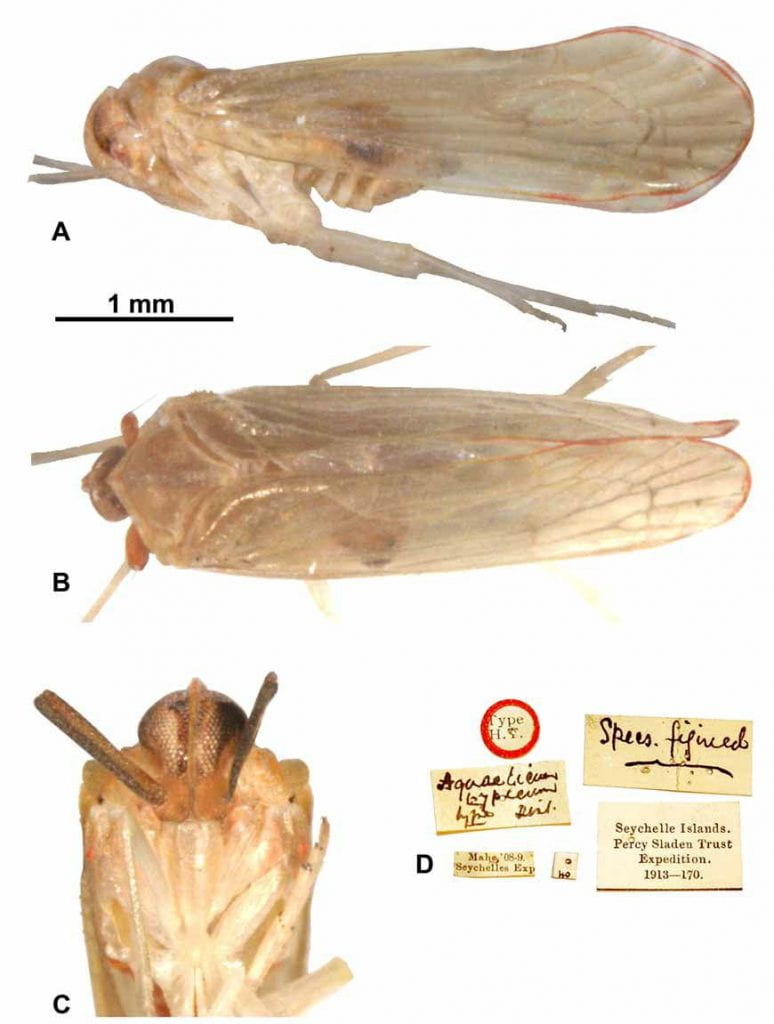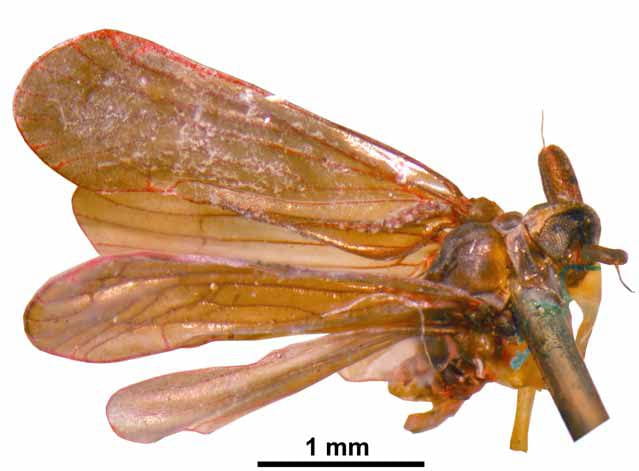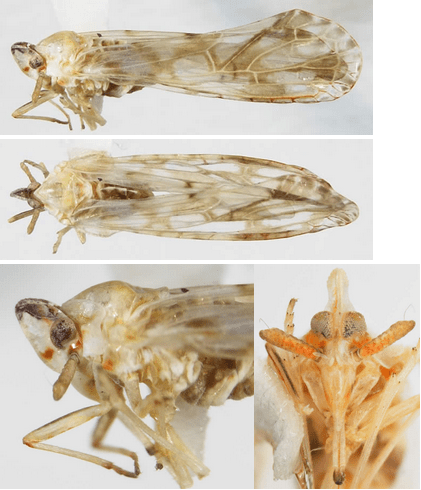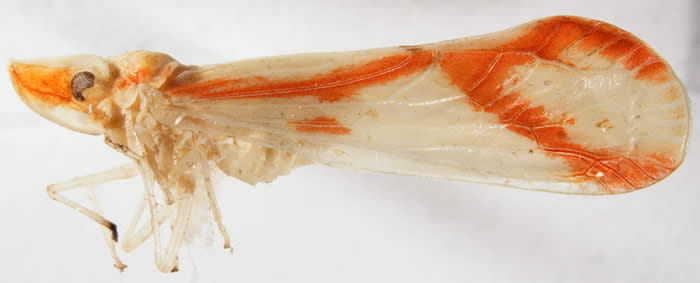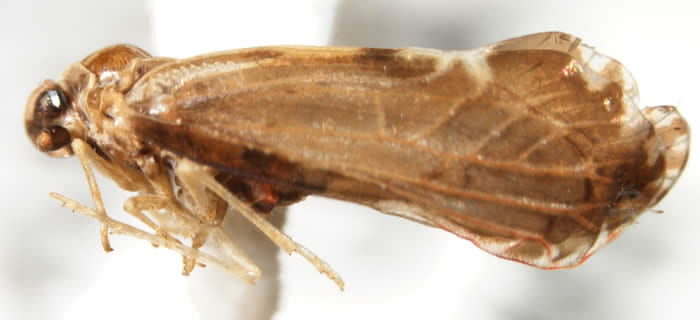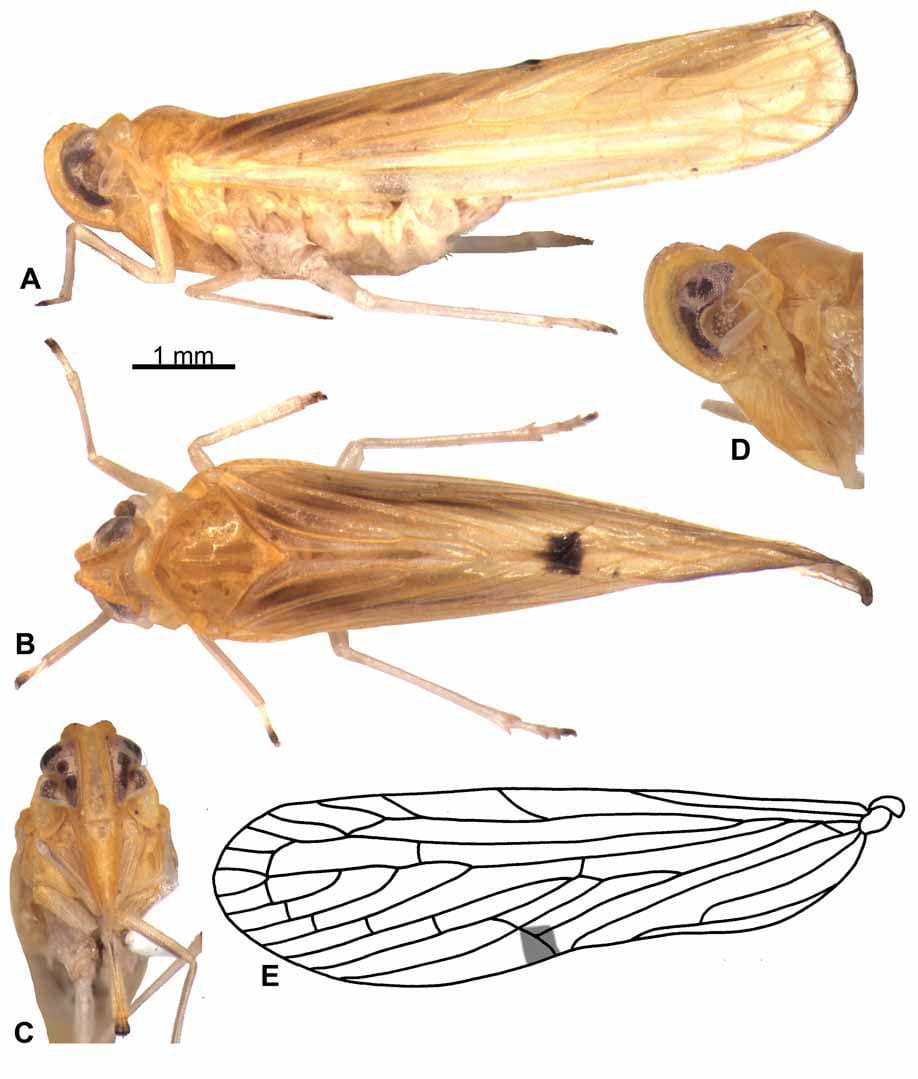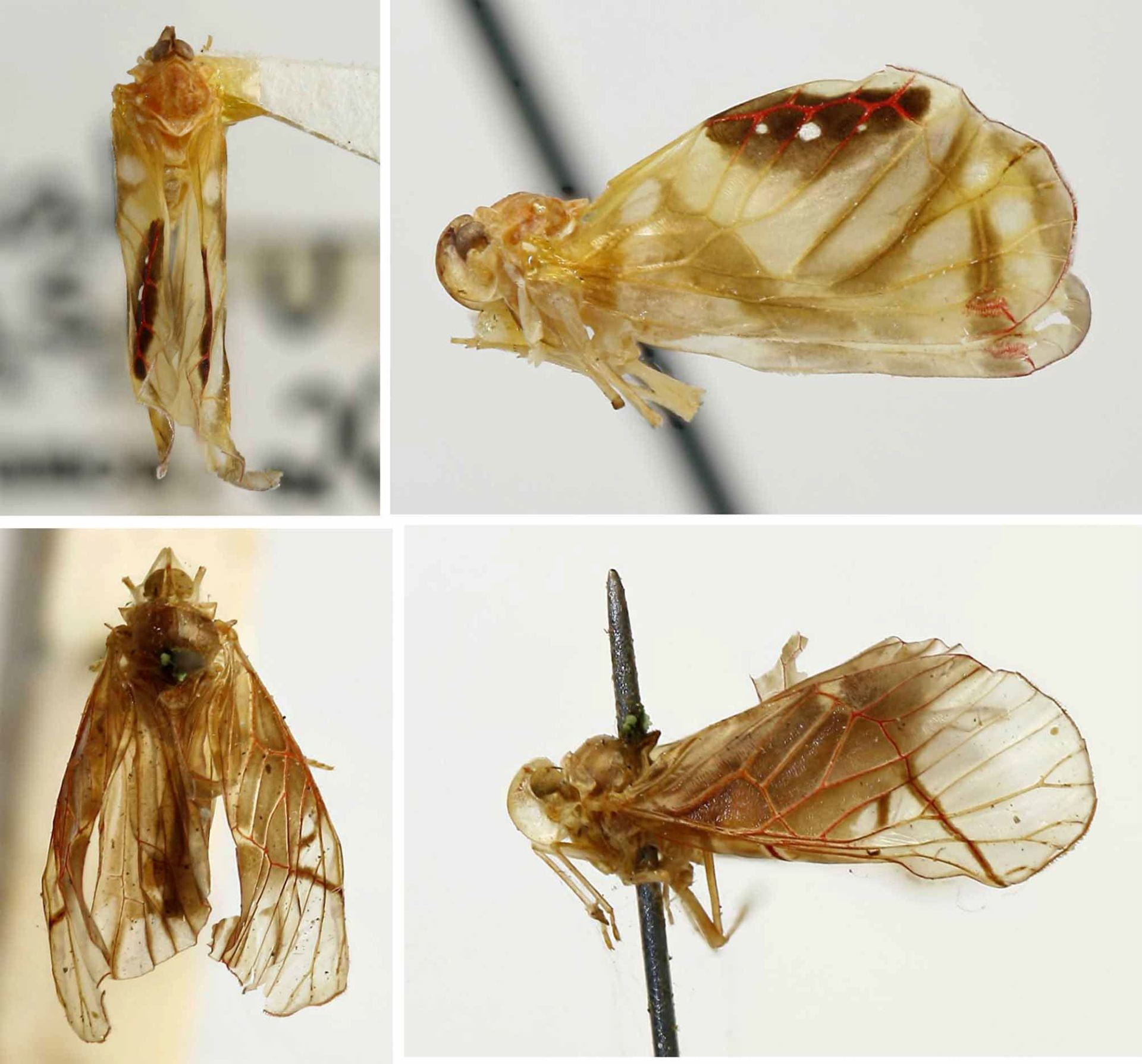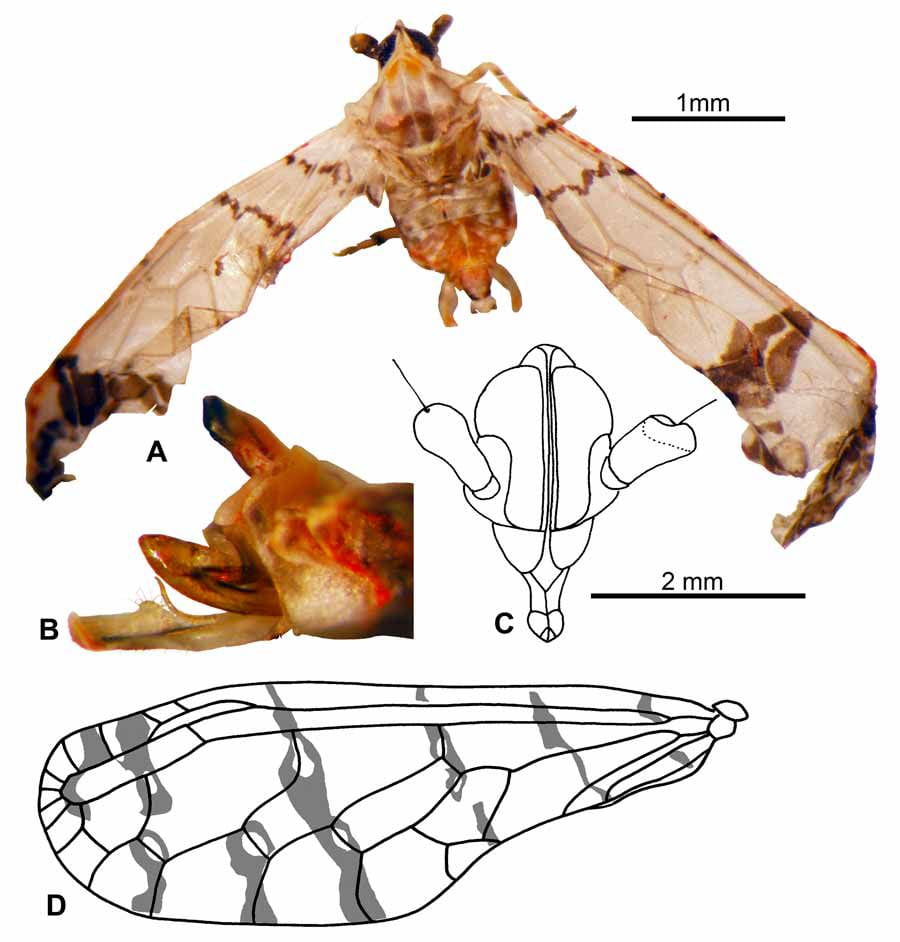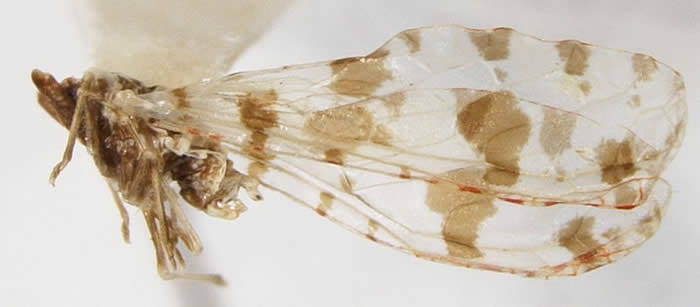Muir (1913) divided the Derbidae into 4 groups that were not formally named, based principally on features of the forewing venation (length of the tegmen relative to the body, cubital veins reaching or not reaching the hind margin of the wing, third claval cell open, extending along the hind margin to last apical median cell) or closed, cubitus with 0-1 forks vs. 2+), and modifications of the head and prothorax around the antennae. The four informal groups were referred to as the 1. Cenchrea, 2. Otiocerus, 3. Sikaiana+Zoraida, 4. Derbe+Mysidia (and Rhotana) groups. In 1917, Muir formalized these into subfamilies, except groups 3 and 4 were combined but excluded Rhotana, and the groups were formalized into the 1. Cenchreinae, 2. Otiocerinae, 3. Derbinae (Derbini including Zoraida, Sikaianini), and 4. Rhotaninae, and a key to subfamilies (and genera in the Philippines) provided. In 1918a, Muir described the Zoraidinae (Zoraidini, Sikaianini), and (1918b) revised the concepts of Derbinae to include tribes Derbini, Cenchreini, Otiocerini, and Rhotanini; with keys to genera. This classification was reaffirmed in Muir (1923) and modified slightly by Muir (1930), who presented a key to subfamilies and tribes.
The revised classification in Muir (1918a, b; 1930) was adopted (with modifications) in the Metcalf catalogue (1945) is a modification of the classification proposed by Muir in 1918 as modified in 1930, as follows.
Family DERBIDAE
Subfamily ZORAIDINAE
Tribe ZORAIDINI
Tribe SIKAIANINI
Subfamily DERBINAE
Tribe DERBINI
Tribe RHOTANINI
Tribe CENCHREINI
Tribe OTIOCERINI
Higher taxonomy was entirely revised and reinterpreted by Fennah (1952) (using 6 tribes, but not specifying subfamilies). Fennah critiqued the principle diagnostic features utilized my Muir (viz. forewings having a reduced or normal cubital area, and “tegmina long and narrow” [in Zoraidinae]) as ignoring other points of similarity that suggested phylogenetic affinities. Fennah discussed a series of other features of potential phylogenetic significance, presented keys to tribe and genus, and redescribed principle groups. Fennah asserted that his Cenchreini (which in his definition included Cedusa) was the most basal group of Derbidae. Fennah’s classification was functionally similar to Muir’s, although genera were rearranged.
Family Derbidae
Subfamily Derbinae
Tribe Zoraidini
Tribe Sikaianini
Tribe Otiocerini
Tribe Rhotanini
Tribe Derbini
Tribe Cenchreini
Subsequently, Broomfield (1985) modified the classification of Derbidae as follows, describing the new tribe Mysidiini. The Mysidiini were revised with 6 genera and 136 species described, with keys to genera and species and amply illustrated.
Emeljanov (1992, 1996) subsequently revised higher taxa (mostly using sensory pits on the body and forewing venation). He utilized 3 subfamilies – Derbinae, Otiocerinae (= Zoraidinae) and Cedusinae. Emeljanov sunk Mysidiini under Derbini (now a subtribe) and creating a series of new tribes (viz. Ipsnolini, Goneokarellini, Phrygiini, Vinatini, Cedusini (including subtribe Eocenchreina), Cedochreini, Dawnarioidini, Nicertini, Kamendakini, Patarini, Neocyclocarini and Phenicini), using a sequence of new features (some elaborate), including the development of an antennal cup (along with associated details), the enlarged antennal pedicle (of males), and the presence and location of sensory pits on the imago. Emeljanov 1992 described Vinatini, Cedusini, Cedusinae and Nicertini; and Emeljanov (1996) described 9 new tribes, but recognized only 2 subfamilies (Derbinae and Otiocerinae); he also gave a key to tribes, that some potentially challenging diagnostic features such as the presences of stridulatory structures on the hind wing (e.g., on the jugal margin). Yang and Wu (1994) followed Emeljanov (1992), but Emeljanov (1996) did not place some of Yang & Wu’s (1994) new genera in his subtribes of Zoraidini.
Cladogram from Emeljanov (1996)
Emeljanov & Fletcher (2004: 40) moved Breddiniolini Fennah, 1950 from the Achilidae to the Derbidae (to Cedusinae). Emeljanov (1990) also described the Eocene tribe Ptychoptilini, moved from the Achilidae by Szwedo (2008). Szwedo (2005, 2006, 2008) presented some modifications to Emeljanov’s (1996) arrangement (esp. to Otiocerines), as did Emeljanov (2008).
Emeljanov & Shcherbakov (2020) described the new tribe Derbachilini Emeljanov & Shcherbakov 2020† including 2 species in 2 genera from mid-Cretaceous Burmese amber. They revised the status of Cedusinae Emeljanov, 1992, observing that Breddiniolini Fennah, 1950 should have priority as Breddiniolinae Fennah, 1950. Because this work is recent, I am still working to understand the implications of these changes.
A commentary on higher-level features is adopted (abridged and lightly edited) below directly from Emeljanov & Shcherbakov (2020)
The Derbinae was separated from Cedusinae by the presence of sensory pits in the adult (Emeljanov 1996). The presence of sensory pits on the head, as well as the costa and clavus in the forewing, was the only criterion for distinguishing Cedochreini and Cenchreini (Derbinae) from Cedusini (Cedusinae): the pits are absent in Cedusini as opposed to present on the basal part of the costa in Cedochreini, and on the head, the costa and Pcu in Cenchreini (Emeljanov, 1992, 1996). However, there are exceptions: in some Cedochreini the pits are developed also at the scutellar margin of clavus (Cedochrusa Emeljanov, 2008; Emeljanov, 2008a, fig. 12), and vice versa, the pits on tegmen are restricted to the basal part of the costa also in some Cenchreini (Dawnaria girdlestoni (Muir, 1913)), Nicertini (Leptaleocera coccinea Muir, 1913) and Otiocerini (Paralyricen jepsoni Muir, 1913; Platocera annulipes Muir, 1913, Pyrrhoneura immaculata Muir, 1913, etc.) [Muir, 1913, pl. 3].
Another important set of character changes at the transition from the basal derbid tribes to Derbinae is associated with the apex of clavus, postclaval area and postclaval crossvein. Achilidae and the most primitive, still achilid-like derbids (grade A) have tegmina not as long as the body, their postnodal parts overlapping in repose (often short) and sometimes with extra folding, the apex of the clavus transversely or obliquely truncate, CuP sharply bent posteriorly near the apex, Pcu+1A joining CuP there, CuA2 reaching apical margin, claval furrow continued into long and wide postclaval area, and postclaval crossvein long and transverse. Somewhat more derived derbids that had lost the achilid habitus (grade B), have the tegmina longer than the body length, steeply tectiform in repose, CuP nearly straight apically, and Pcu+1A joining either CuP near the apex (Cedusini Eocenchreina, Cedochreini, some Cenchreini—e.g. Goneokara Muir, 1913, Agoo Bahder et Bartlett, 2019), or 2A or their junction (cixiid condition restored: Cedusina, Dawnarioidini, other Cenchreini—e.g. Basileocephalus Kirkaldy, 1906, Dawnaria Distant, 1911). Further transformations of the claval region occur in still more derived derbids: CuP after the junction with Pcu+1A running along posterior margin up to postclaval crossvein, clavus open, postclaval area short and narrow, CuA2 joining posterior margin, postclaval crossvein short and oblique. This condition recorded already in a few Cenchreini (some Phaciocephalus Kirkaldy, 1906, Herpis Stål, 1862), is further developed in higher Derbidae (Fennah, 1952). The characters that unite all Derbidae are the fusion of tergite IX with the anal tube in males, and probably also peculiar wax pores on the abdomen. In the evolution of Derbidae, there was a transformation of the basal, achilid-like forms into higher derbids through the accumulation of derived characters. Accordingly, the tribes of Derbidae were arranged in a phylogenetic sequence [Emeljanov, 1995]. The character changes that have occurred from primitive tribes to typical derbids are as follows (described as ‘derbization of achilids’):
(1) shortening of the apical segment of rostrum—at least thrice as long as wide in Breddiniolini, Ipsnolini, Goneokarellini, Vinatini, Ptychoptilini, Derbachilini; at most twice in other derbids (except for Archara Metcalf, 1945 of Otiocerini) [Fennah, 1952];
(2) reduction of lateral teeth on hind tibia—four or three teeth in Breddiniolini; three or two in Derbachile gen.n.; two in Vinatini; one tooth in Ipsnolini, Goneokarellini, Phrygiini and Eocenchrea Muir, 1913 (Cedusini Eocenchreina); no teeth in other derbids, except Zoraidini and Sikaianini;
(3) reduction of subapical setae on apical pectens of hind tarsomeres — setae present in Breddiniolini and Ipsnolini; absent in Derbachile and other derbids;
(4) medial shortening of the pronotum and reduction of its disc—pronotal disc elevated, tricarinate, triangular, nearly as long as wide in Ipsnolini, Vinatini, Ptychoptilini, Derbachile; much shorter in Goneokarellini, Phrygiini, some Cenchreini; not elevated, ecarinate in other derbids;
(5) reduction of M fork in the hind wing — M forked before r-m in Breddiniolini, Derbachilini; beyond r-m in Ipsnolini, Phrygiini, Cedochreini; simple in other primitive derbids;
(6) reduction of CuA1 fork in the hind wing — CuA1 forked before m-cu in Breddiniolini; beyond m-cu in Ipsnolini, Goneokarellini, Phrygiini, Phrygiini, Derbachilini; simple in other derbids;
(7) modification of antenna — enlarged and somewhat flattened in Derbachilini trib.n.; enlarged in Vinatini, Derbini, and flattened in some Otiocerinae;
(8) development of subantennal lobe — ridge at lorogenal boundary in Phrygiini [Emeljanov, 1995]; low ridge in Derbachile hochae; lobe in Cedusini, Cedochreini, Cenchreini, most Otiocerinae;
(9) shortening of ScRA in the hind wing—in Cedusini (except Emeljanovedusa Szwedo, 2006 from Baltic amber) and higher tribes;
(10) increase of wing/body size ratio — tegmen length greater than body length in Breddiniolini, Derbachilini, and in Cedusini and higher tribes;
(11) loss of tegminal overlap and truncate apex of clavus—tegmina overlapping, clavus truncate in Breddiniolini, Ipsnolini, Goneokarellini, Phrygiini, Vinatini, Ptychoptilini and Derbachilini; tegmina not overlapping, clavus more acute or open in Cedusini and higher tribes;
(12) development of sensory pits in adults—on costa in tegmen (sometimes on its base only) in Derbachilini, Dawnarioidini, and some Cedochreini, Cenchreini, Nicertini and Otiocerini; on C and/or other veins and/or head in higher tribes.
Higher taxonomy of Derbidae (from FLOW) as of Jan 2018
Family Derbidae Spinola 1839: 205
= Derboides Spinola 1839: 205 (original spelling)
Subfamily Breddiniolinae Fennah, 1950 (status revised by Emeljanov & Shcherbakov 2020)
= Cedusinae Emeljanov 1992, syn by Emeljanov & Shcherbakov 2020: 238.
= Cedusini Emeljanov 1992; status (subfamily) by Emeljanov 1996
Tribe Breddiniolini Fennah 1950: 36 (Transferred from Achilidae by Emeljanov & Fletcher 2004)
Breddiniola Muir, 1934: 581[Africa]
Breddiniolella Fennah, 1950: 37 (fiji)
Hemielissum Emeljanov & Fletcher, 2004 (Australia)
Tribe Cedusini Emeljanov 1992
Subtribe Cedusina Emeljanov 1992 (sensu Emeljanov 2008)
Cedusa Fowler, 1904
Emeljanovedusa† Szwedo, 2006
Hauptenia Szwedo, 2006
Malenia Haupt, 1924
Muiredusa Szwedo, 2006
Produsa Szwedo, 2006
Subtribe Eocenchreina Emeljanov 1992
Anticedusa Emeljanov, 2008 (1 species, Costa Rica)
Eocenchrea Muir, 1913 (=Eocenchres, missp. by Emeljanov 2006: 82)
Melusa Emeljanov, 1995
Tribe Derbachilini Emeljanov & Shcherbakov 2020†
Derbachile Emeljanov & Shcherbakov 2020†
Achiderbe Emeljanov & Shcherbakov 2020†
Tribe Goneokarellini Emeljanov 2006: 77
Goneokarella Fennah, 1952
Tribe Ipsnolini Emeljanov 1996: 76
Ipsnola Signoret, 1885
Tribe Phrygiini Emeljanov 1996: 76 (genus placed variously in Achilidae and Derbidae)
Phrygia Stål, 1856 (1 species, Brazil)
Tribe Ptychoptilini† Emeljanov, 1990
Ptychogroehnia† Szwedo & Stroinski, 2001
Ptychoptilum† Emeljanov, 1990
Tribe Vinatini Emeljanov 1992
Anerana Emeljanov, 1992
Vinata Distant, 1906 (= Erana Walker 1857, preoccupied, replaced by Vinata Distant, 1906; = Feredayia Kirkaldy, 1910 synonym of Vinata Distant, 1906 by ???)
Subfamily Derbinae Spinola 1839
Tribe Cedochreini Emeljanov, 1996: 82[1]
Cedochrea Emeljanov, 1996 (1 species, Costa Rica)
Cedochrusa Emeljanov 2008
Tribe Cenchreini Muir, 1917: 54
= Cenchreinae Muir, 1917; status (tribe) by Muir, 1918.
Aethocauda Williams, 1976
Agoo Bahder & Bartlett 2019
Amania Synave, 1973
Anchimothon Fennah, 1952
Basileocephalus Kirkaldy, 1906 (= Aulacocephala Perroud & Montrouzier, 1864 nomen praeoccupatum replaced by Aculocephala Metcalf, 1945; Aculocephala Metcalf, 1945 synonym of Basileocephalus Kirkaldy, 1906 according to Fennah 1969; = Urabunna Distant, 1907 synonym of Basileocephalus Kirkaldy, 1906 by Kirkaldy 1907: 163)
Cenanges Fennah, 1952
Cenchrea Westwood, 1840
Contigucephalus Caldwell, 1944
Copallinges† Szwedo, 2004
Cyclometopum Muir, 1913
Dawnaria Distant, 1911
Fordicidia Distant, 1917
Goneokara Muir, 1913
Herpis Stål, 1862 (= Syntames Fowler 1905: 138)
Lamenia Stål, 1859
Muirileguatia Metcalf, 1945
Neocenchrea Metcalf, 1923
Neolamenia Muir, 1917
Omolicna Fennah, 1945
Oropuna Fennah, 1952
Perandenina Distant, 1911
Persis Stål, 1862
Phaciocephalus Kirkaldy, 1906
Vekunta Distant, 1906
Tribe Dawnarioidini Emeljanov 1996: 76; 2006: 84
Dawnarioides Dozier, 1929
Neodawnaria O’Brien, 1982
Tribe Derbini Spinola 1839
= Mysidiini Broomfield 1985: 5; syn by Emeljanov ….
Subtribe Derbina Spinola, 1839
Derbe Fabricius, 1803
Subtribe Mysidiina Broomfield, 1985
Amysidiella Broomfield, 1985
Dysimia Muir, 1924
Dysimiella Broomfield, 1985
Ipsemysidia Broomfield, 1985
Mysidaloides Broomfield, 1985
Mysidia Westwood, 1840
Neomysidia Broomfield, 1985
Paramysidia Broomfield, 1985
Pseudomysidia Metcalf, 1938
Symidia Muir, 1918
Tribe Nicertini Emeljanov 1992
Nicerta Walker, 1857
Subfamily Otiocerinae Muir, 1917
= Subfamily Zoraidinae Muir 1918b: 173 (as subfamily and tribe)[2]
Tribe Aquaeliciini Banaszkiewicz & Szwedo, 2005
Aquaelicium Distant, 1917
Ileifea Banaszkiewicz & Szwedo, 2005
Muiravea Banaszkiewicz & Szwedo, 2005
Ravola Banaszkiewicz & Szwedo, 2005
Razanus Banaszkiewicz & Szwedo, 2005
Synavea Emeljanov, 1995
Vizimbum Banaszkiewicz & Szwedo, 2005
Aquaelicium typicum (lectotype) from Locker et al 2009; scalebar applies to figures A–B.
Tribe Kamendakini Emeljanov 2006: 87
Kamendaka Distant, 1906 (= Nicertoides Matsummura 1910: 14 (subgenus), = Eosaccharissa Kirkaldy 1907: 125 (subgenus))
Tribe Neocyclokarini Emeljanov 2006: 89
Neocyclokara Muir, 1917
Tribe Nicertini Emeljanov, 1992
Epotiocerus Matsumura, 1914
Interamma Walker, 1870
Leptaleocera Muir, 1913
Megatropis Muir, 1913
Nicerta Walker, 1857
Robigus Distant, 1911
Vivaha Distant, 1906
Tribe Otiocerini Muir, 1917: 54
= Otiocerinae Muir, 1917: 54; status (tribe) by Muir 1918: 229; returned to subfamily by Broomfield 1985 (also subfamily in Em., 2006)
Anomaladerbe Muir, 1922
Anotia Kirby, 1821 (= Amalopota Van Duzee 1889: 176)
Apache Kirkaldy, 1901
Archara Metcalf, 1945
Banksiella Muir, 1917
Cobacella Fennah, 1952
Dendrokara Melichar, 1914
Deribia Westwood, 1841
Eusyphax Fennah, 1956
Flaccia Stål, 1866
Harpanor Fennah, 1950
Heronax Kirkaldy, 1906
Kaha Kirkaldy, 1906
Kampulokara Muir, 1913
Kubilaya Koçak & Kemal, 2010 (=Iquitosa Fennah, 1945 nomen praeoccupatum replaced by Kubilaya Koçak & Kemal, 2010)
Kuranda Distant, 1907
Labicerus Erichson, 1848
Lugeilangor† Szwedo, 2005
Makula Distant, 1907
Mysidioides Matsumura, 1905
Neodendrokara Muir, 1917
Nesocore Kirkaldy, 1907
Nesokaha Muir, 1913
Nesoneura Kirkaldy, 1907
Nesoniphas Kirkaldy, 1907
Niphadodite Kirkaldy, 1907
Otiocerus Kirby, 1821
Paralyricen Muir, 1913
Pepleuca Emeljanov, 1999 (= Platocera Muir, 1913 synonym of Pepleuca Emeljanov, 1999 by ??)
Phra Distant, 1911
Platocerella Fennah, 1952
Platonax Metcalf, 1938
Positrona† Emeljanov, 1994
Pyrrhoneura Kirkaldy, 1906
Pyrrhonice Emeljanov, 1994
Sayiana Ball, 1928
Shellenius Ball, 1928
Swezeyia Kirkaldy, 1906
Tempora Matsumura, 1914
Tribe Patarini Emeljanov 2006: 89 (redefined Banaszkiewicz & Szwedo, 2005)
Anapatara Emeljanov, 1995
Patara Westwood, 1841
Tribe Phenicini Emeljanov 2006: 92
Equirria Distant, 1917
Fescennia Stål, 1866
Metaphenice Emeljanov, 1995
Paraphenice Muir, 1924 (=Imbalara Hesse, 1925 synonym of Paraphenice Muir, 1924 by Muir 1928: 502)
Phenice Westwood, 1840
Tribe Rhotanini Muir, 1918: 228-229
= Rhotaninae Muir, 1918; status (tribe) by Muir, 1918; RESTORED to subfamily be Broomfield 1985; reduced to tribe in Emeljanov 1996.. see Zelazny & Webb (2011)
Alara Distant, 1911
Dichotropis Muir, 1913
Levu Kirkaldy, 1906
Muiralevu Zelazny, 1981 (=Formolevu Yang & Wu, 1993 synonym of Muiralevu Zelazny, 1981 according to Zelazny & Webb 2011: 55
Rhotana Walker, 1857 (= Decora Bierman, 1910, = Genestia Stål, 1858)
Rhotanella Fennah, 1970
Saccharodite Kirkaldy, 1907
Sumangala Distant, 1911
Tribe Sikaianini Muir 1917: 56
Ceropupa Emeljanov, 1995
Distantinia Muir, 1917
Leomelicharia Muir, 1913
Muiria Kirkaldy, 1907
Mula Ball, 1928 but placed in Patarini elsewhere
Sikaiana Distant, 1907 (= Euklastus Metcalf 1923)
Tribe Zoraidini Muir 1918b: 173 (http://biodiversitylibrary.org/page/34176021)
= Subfamily Zoraidinae Muir 1918: 173; status (tribe) by Fennah 1952 (subfamily not indicated); status (subfamily) by Broomfield (1984: 4); status (tribe of Otiocerinae) by Emeljanov (2006: 92)/
Subtribe Lyddina Emeljanov 2006: 92
Acanthocerana Metcalf, 1945 (doubtfully included Em. 2006)
Diostrombus Uhler, 1896
Formodanga Yang & Wu, 1993
Helcita Stål, 1856
Lydda Westwood, 1840
Lyddastrombus Van Stalle, 1992
Neoproutista Yang & Wu, 1993
Pamendanga Distant, 1906
Proutista Kirkaldy, 1904
Shizuka Matsumura, 1914
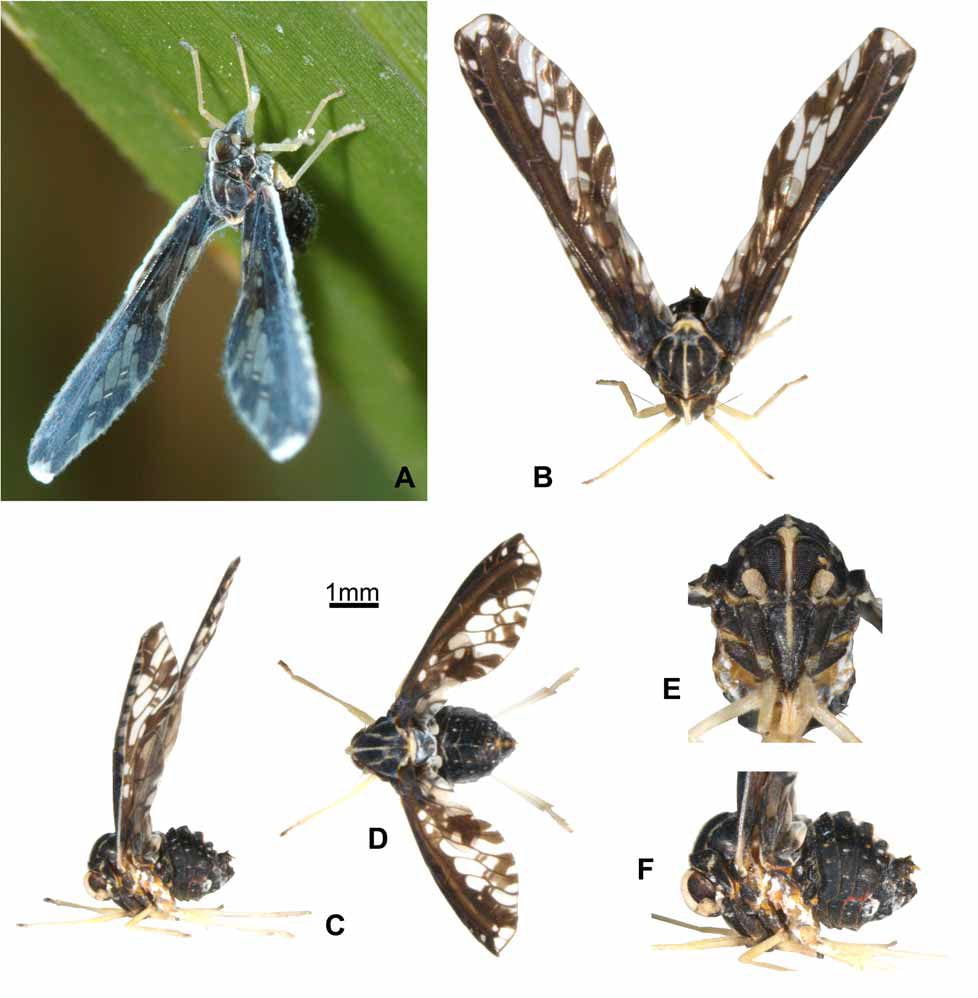
Proutista moesta (From Locker et al 2009): A–D habitus; E head; F body lateral. Scalebar 1 mm applies to figures B–D.
Subtribe Zeugmatina Emeljanov 2006: 92 (Emeljanov, 1995)
Zeugma Westwood, 1840
subtribe Zoraidina Muir 1918: 173 (status by Emeljanov 2006: 93; constituent genera from Metcalf less genera specified in Emeljanov 2006)
Losbanosia Muir, 1917
Monochorhynchus Muir, 1917
Neocamma Melichar, 1915
Neodiostrombus Muir, 1918
Neozoraida Muir, 1918
Parapamendanga Yang & Wu, 1993
Parapeggia Yang & Wu, 1993
Peggia Kirkaldy, 1901
Peggiopsis Muir, 1913
Pseudohelcita Muir, 1918
Raizoda Muir, 1924
Shirakiana Metcalf, 1945
Stenopeggia Fennah, 1952
Teutberga Jacobi, 1917
Zorabana Van Stalle, 1984
Zoraida Kirkaldy, 1900
Zoraidoides Distant, 1914
Incertae
Diprora Williams, 1976
Nesorhamma Fennah, 1956
Stenogeggia Fennah, 1952 (may just be a misspelling of Stenopeggia)
References [Incomplete, borrowed freely from FLOW]
Bahder, B.W., C.R. Bartlett, E. A. Barrantes Barrantes, M.A. Zumbado Echavarria, A. R. Humphries, E.E. Helmick, M.S. Ascunce and E.M. Goss. 2019 A new species of Omolicna (Hemiptera: Auchenorrhyncha: Fulgoroidea: Derbidae) from coconut palm in Costa Rica and new country records for Omolicna brunnea and Omolicna triata. Zootaxa 4577 (3): 501–514. https://doi.org/10.11646/zootaxa.4577.3.5
Bahder, B. W., C. R. Bartlett, E. E. Helmick, E. A. Barrantes Barrantes, M. A. Zumbado Echavarria, E. M. Goss and Marina S. Ascunce. 2020 Revised status of Omolicna subgenus Agoo (Hemiptera: Auchenorrhyncha: Fulgoroidea: Derbidae) with a new species from Costa Rica and new country records. Zootaxa 4718(4): 521–535. http://dx.doi.org/10.11646/zootaxa.4718.4.6
Ball, E. D. 1902. New genera and species of N. A. Fulgoridae. Canadian Entomologist 34: 259-266.
Ball, E. D. 1928. Some new genera and species of N. A. Derbidae with notes on others (Fulgoridae). The Canadian Entomologist 60: 196-201 .
Banaszkiewicz, M. and J. Szwedo. 2005. Notes on Otiocerinae with description of a new tribe from Madagascar and Africa (Hemiptera: Fulgoromorpha: Derbidae). Annales Zoologici 55(2): 223-241. [key to tribes]
Bartlett, C. R., O’Brien L. B. & Wilson S. W. 2014. A review of the planthoppers (Hemiptera: Fulgoroidea) of the United States. Memoirs of the American Entomological Society 50: 1-287.
Bourgoin, T. and M. R. Wilson. 1992. A new species of Myndus (Fulgoromorpha, Cixiidae) from coconut palms in New Caledonia. Mitteilungen der Schweizerischen Entomologischen Gesellschaft 65: 69-74.
Broomfield, P. S. 1985. Taxonomy of Neotropical Derbidae in the new tribe Mysidiini (Homoptera). Bulletin of the British Museum (Natural History). Entomology 50(1): 1-152.
Burmeister, H. C. C. 1835. Schnabelkerfe. Rhynchota. Fascicule 1. In: Burmeister H. C. C. 1835. Handbuch der Entomologie, 2. p. 99-183.
Caldwell, J. S. & Martorell L. F. 1951. Review of the auchenorynchous Homoptera of Puerto Rico.” Part II. The Fulgoroidea except Kinnaridae. Journal of Agriculture of the University of Puerto Rico [1950], 34(2): 133-269.
Caldwell, J. S. 1944. The genus Cedusa in Mexico and Central America. (Hem. Fulg.). Anales de la Escuela Nacional de Ciencias Biologicas (Mexico) 3: 445-462.
Caldwell, J. S. 1944. The tribe Cenchreini with special reference to the Cenchrea complex (Homoptera, Derbidae). Bulletin of the Brooklin Entomological Society 39: 99-110.
De Motschulsky, V. I. 1863. Essai d’un catalogue des insectes de l’ile de Ceylan. Bulletin de la Société Impériale des Naturalistes de Moscou 36: 1-153.
Distant, W. L. 1906. Preoccupied generic names in the Homopterous family Fulgoridae. The Entomologist. An illustrated Journal of Entomology 39: 8.
Distant, W. L. 1911. Descriptions of new genera and species of Oriental Homoptera. Annals and Magazine of Natural History. London (Ser. 8) 8: 639-649.
Distant, W. L. 1917. Rhychota. Part ii: Suborder Homoptera. The Percy Sladen Trust Expedition to the Indian Ocean in 1905, under the leadership of Mr. J. Stanley Gardiner, M. A. The Transactions of the Linnean Society of London. Second series. Zoology 17: 273-322 [290].
Dlabola, J. 1979. Insects of Saudi Arabia. Homoptera. Fauna of Saudi Arabia 1: 115-139.
Dlabola, J. 1986. Neue arten der fulgoromorphen zikaden-familien vom mittelmeergebiet und nahen osten (Homoptera, Auchenorrhyncha: Cixiidae, Meenoplidae, Derbidae, Dictyopharidae, Lophopidae und Issidae). Acta Entomologica Musei Nationalis Pragae 42: 169-193.
Dozier, H. L. 1928. The Fulgoridae or planthoppers of Mississippi, including those of possible occurrence. A taxonomic, biological, ecological, and economic study. Technical Bulletin. Mississippi Agricultural Experiment Station 14: 1-152.
Dozier, H. L. 1929. A new genus and species of derbid from Porto Rico. American Museum Novitates. Published by the American Museum of Natural History 371: 1-2.
Emeljanov, A. F. 1990. Novy rod i triba semeïstva Achilidae (Homoptera, Cicadina) iz baltiïskogo yantarya. Vestnik Zoologii 1: 6-10.
Emeljanov, A. F. 1992. Two new tribes, a new genus and a new species of the family Derbidae (Homoptera, Fulgoroidea). Vestnik Zoologii 4: 19-23 [19].
Emeljanov, A. F. 1995. K voprosu o sistemie i filogenii sem. Derbidae (Homoptera, Cicadina) [On the System and Phylogeny of the Family Derbidae (Homoptera, Cicadina)]. Entomologicheskoe Obozrenie (1994) 73(4): 783-811.
Emeljanov, A. F. 1996. On the system and phylogeny of the family Derbidae (Homoptera, Cicadina). Entomological Review 75(2): 70-100.
Emeljanov, A. F. 2008. Two new genera of the family Derbidae from the New World, with description of Recent and an extinct Miocene new species (Homoptera, Fulgoroidea). Entomologicheskoe Obozrenie 87(4): 791-798.
Emeljanov, A. F. and D. E. Shcherbakov. 2000. Kinnaridae and Derbidae (Homoptera, Fulgoroidea) from the Dominican amber. Neues Jahrbuch für Geologie und Paläontologie Monatshefte 7: 438-448.
Emeljanov, A.F. and D. Shcherbakov. 2020 The first Mesozoic Derbidae (Homoptera: Fulgoroidea) from Cretaceous Burmese amber. Russian Entomological Journal 29(3): 237-246. https://doi.org/246. 10.15298/ rusentj.29.3.02
Emeljanov, A. F. and M. J. Fletcher. 2004. Hemielissum evansi, a new genus and species of Breddiniolini (Hemiptera: Fulgoromorpha), being the first Australian record of the tribe, with a discussion of the taxonomic position of the Breddiniolini. Australian Journal of Entomology 43: 38-42.
Fabricius, J. C. 1803. Systema Rhyngotorum secundum ordines, genera, species, adiectis synonymis, locis, observationibus, descriptionibus. 1803: 314 pp. [80]
Fennah, R. G. 1945. The Fulgoroidea, or lanternflies, of Trinidad and adjacent parts of South America. Proceedings of the United States National Museum. Washington 95: 411-520 [441].
Fennah, R. G. 1950. A generic revision of the Achilidae (Homoptera: Fulgoridea). Bulletin of the British Museum (Natural History). Entomology 1: 1-170 [36].
Fennah, R. G. 1952. On the generic classification of Derbidae (Fulgoroidea), with descriptions of new Neotropical species. Transactions of the Royal Entomological Society of London 103(4): 109-170.
Fennah, R. G. 1956. Homoptera: Fulgoroidea. Insects Micronesia 6(3): 39-211 [158].
Fennah, R. G. 1957. Results from the Danish Expedition to the French Cameroons, 1949-50 XXIV. Fulgoroidea. Bulletin de l’Institut Français Afrique Noire. (Ser. A) 19: 1274-1311.
Fennah, R. G. 1958. Fulgoroidea from the Belgian Congo (Hemiptera: Homoptera). Annales du Musée du Congo Belge (Sciences Zoologique). (Ser. 8) (1957) 59: 1-206.
Fennah, R. G. 1969. Fulgoroidea (Homoptera) from New Caledonia and the Loyalty Islands. Pacific Insects Monography 21: 1-116.
Fennah, R. G. 1971. Fulgoroidea from the Cayman Islands and adjacent areas. Journal of Natural History 5: 299-342.
Fitch, A. 1851. Catalogue with references and descriptions of the insects collected and arranged for the State Cabinet of Natural History. Annual Report of the Regents of the University on the Condition of the State Cabinet of Natural History, and the Historical and Antiquarian Collection. Albany, New York 4: 43-69.
Flynn, J. E. & Kramer J. P. 1983. Taxonomic study of the planthopper genus Cedusa in the Americas (Homoptera: Fulgoroidea: Derbidae). Entomography 2: 121-260.
Fowler, W. W. 1900. Order Rhynchota. Suborder Hemiptera-Homoptera. (Continued). Key to the genera of the subfamily Ricaniinae and descriptions of the n. spp. of this subfamily and the family Derbidae. Biologia Centrali-Americana; contributions to the knowledge of the fauna and flora of Mexico and Central America 1: 57-76.
Fowler, W. W. 1904. Order Rhynchota. Suborder Hemiptera-Homoptera. (Continued). Biologia Centrali-Americana; contributions to the knowledge of the fauna and flora of Mexico and Central America 1: 85-124.
Fowler, W. W. 1905. Order Rhynchota. Suborder Hemiptera-Homoptera. (Continued). Biologia Centrali-Americana; contributions to the knowledge of the fauna and flora of Mexico and Central America 1: 125-139.
Haupt, H. 1924. Zur Kenntnis der Homopteren-Fauna Siciliens. Memorie della Societa Entomologica Italiana 3: 228-235.
Horváth, G. 1907. Hemiptera nova vel minus cognita e regione palaearctica. I. Annales Historico-Naturales Musei Nationalis Hungarici 5: 289-323.
Jacobi, A. 1928. Rhynchota Homoptera. 1. Fulgoridae und Cercopidae in Results of Dr. E. Mjöberg’s Swedish Scientific Expeditions to Australia 1910-1913. Arkiv for Zoologi. Utgifvet af K. Svenska Vetenskaps-akademien 19(28): 1-50.
Jhan, Pijush Kanti, Rahman Mohammad Atikur, Khan Md. Mohasin Hussain & Jahan S. M. Hemayet 2016. A newly recorded genus Hauptenia Szwedo (Hemiptera: Fulgoromorph: Derbidae) in Bangladesh, with description of a new species. International Journal of innovative Research 1(1): 1-4 [2].
Kirby, W. F. 1891. Catalogue of the described Hemiptera Heteroptera and Homoptera of Ceylon, based on the collection formed by Mr. E. Ernest Green. Zoological Journal of the Linnean Society 24: 72-176.
Kirkaldy, G. W. 1906. Leafhoppers and their natural enemies. (Pt. IX Leafhoppers. Hemiptera). Bulletin. Hawaiian Sugar Planters’ Association Experiment Station. Division of Entomology 1(9): 271-479.
Kirkaldy, G. W. 1907. Leafhoppers supplement. (Hemiptera). Bulletin. Hawaiian Sugar Planters’ Association Experiment Station. Division of Entomology 3: 1-186.
Kirkaldy, G. W. 1910. On some preoccupied generic names in insects. The Canadian Entomologist 42: 8.
Koçak, A. O. & Kemal M. 2010. Generic replacement name in the family Derbidae from New Caledonia and Australia. Priamus 12(6): 154.
Kramer, J. P. 1986. Supplement to a taxonomic study of the planthopper genus Cedusa in the Americas (Homoptera: Fulgoroidea: Derbidae). Entomography 4: 245-314 [289].
Linnavuori, R. E. 1973. Hemiptera of the Sudan, with remarks on some species of the adjacent countries. 2. Homoptera Auchenorrhyncha: Cicadidae, Cercopidae, Machaerotidae, Membracidae and Fulgoroidea. (Zoological contribution from the Finnish expeditions to the Sudan No. 33). Notulae Entomologicae 53(3): 65-137.
Löcker, H., B. Löcker and W. E. Holzinger. 2009. Revision of the Derbidae of Seychelles Islands (Insecta: Hemiptera: Fulgoromorpha). Zootaxa 2221: 1-26.
Matsumura, S. 1914. Beitrag zur Kenntnis Fulgoriden Japans. Annales Historico-Naturales Musei Nationalis Hungarici 12: 261-305.
Mc Atee, W. L. 1924. Notes on Cenchrea Westwood and Cedusa Fowler in America (Homoptera: Fulgoroidea). Annals of the Entomological Society of America 17: 175-186 [182].
Melichar, L. 1905. Beitrag zur Kenntnis der Homopterenfauna Deutsch-Ost-Afrikas. Wiener Entomologische Zeitung 24(9 et 10): 279-304 [285].
Metcalf, Z. P. 1923. A key to the Fulgoridae of Eastern North America with descriptions of new species. Journal of the Elisha Mitchell Scientific Society 38: 139-230 [193].
Metcalf, Z. P. 1938. The Fulgorina of Barro Colorado and other parts of Panama. Bulletin of the Museum of Comparative Zoology at Harvard College 82: 277-423.
Metcalf, Z. P. 1945. Fulgoroidea (Homoptera) of Kartabo, Bartica district, British Guiana. Zoologica. Scientific Contributions of the New York Zoological Society 30: 125-144.
Metcalf, Z. P. 1945. Part 4. Derbidae. In: Metcalf Z. P. 1954. General Catalogue of the Homoptera. Fascicule IV, North Carolina State College, Raleigh (United States of America). p. 1-212.
Muir, F. A. G. 1913. On some new species of leafhoppers. Part II. Derbidae. Bulletin. Hawaiian Sugar Planters’ Association Experiment Station. Division of Entomology 12: 28-92.
Muir, F. A. G. 1915. New and little-known Derbidae. Proceedings of the Hawaiian Entomological Society. Honolulu 3: 116-136.
Muir, F. A. G. 1917. The Derbidae of the Philippine Islands. Philippine Journal of Science 12: 49-104.
Muir, F. A. G. 1918. Homopterous notes II. Proceedings of the Hawaiian Entomological Society 3: 414-429 [416].
Muir, F. A. G. 1918. Notes on the Derbidae in the British Museum collection.-II. Derbidae. Entomologist’s Monthly Magazine 54: 228-243 [236].
Muir, F.A.G. 1923f. On the classification of the Fulgoroidea (Homoptera). Proceedings of the Hawaiian Entomological Society 5: 205-247.
Muir, F. A. G. 1924. Notes on some genera of Derbidae (Hemip.). Proceedings of the Entomological Society of Washington 26: 15-19.
Muir, F. A. G. 1925. On some Fulgorids (Hemiptera-Homoptera) from the Island of Rodriguez. Transactions of the Entomological Society of London 1924: 463-474 [469].
Muir, F. A. G. 1934. New and little-known Fulgoroidea (Homoptera). Annals and Magazine of Natural History (Ser. 10) 14: 561-586 [581].
Myers, J. G. 1926. Dry-season studies of cane Homoptera at Soledad, Cuba. Contributions from the Harvard Institute for Tropical Biology and Medicine 3: 69-110 [103].
O’Brien, L. B. 1982. Two neotropical derbid genera with observations on wing roling (Fulgoroidea, Homoptera). Florida Entomologist 65(3): 306-321 [315].
O’Brien, L. B. 1986. Five new species of Fulgoroidea (Homoptera) from the western United States and Mexico. Southwestern Entomologist 11(2): 67-74 [72].
Penny, N. D. & Arias J. R. 1984. Four new species of wing rolling Neodawnaria (Homoptera: Derbidae) from the Amazon basin (1986). Acta Amazonica 14(3-4): 459-471 [460].
Perroud, B. P. & Montrouzier X. 1864. Essai sur la faune entomologique de Kanala (Nouvelle-Calédonie) et description de quelques espèces nouvelles ou peu connues. Annales de la Société Linnéenne de Lyon 11: 46-257.
Rahman, Mohammad Atikur, Kwon Y. J. & Suh S. J. 2012. Two newly recorded genera and three new species of the tribe Cedusini (Hemiptera: Fulgoromorpha: Derbidae) from Korea. Zootaxa 3261: 59-68.
Rodriguez-Leon, R. & Hidalgo- Gato M. M. 2005. Descripción de una nueva especie de Omolicna Fennah, 1945 (Hemiptera: Derbidae) de Cuba. Boletin Sociedad Entomológica Aragonesa 37: 137-139.
Schmidt, E. 1926. Fauna Buruana. Homoptera. Treubia 7(3): 217-258.
Signoret, V. 1885. Liste des Hemiptères recueillis à la Terre de Feu par la Mission de la Romanche et description d’espèces nouvelles. Annales de la Société Entomologique de France. Paris. (Ser. 6) 5: 63-70 [69].
Spinola, M. 1839. Essai sur les Fulgorelles, sous-tribu de la tribu des Cicadaires, ordre des Rhyngotes. Annales de la Société Entomologique de France 8: 133-337 [204].
Stål, C. 1854. Nya Hemiptera. Ofversigt af Kongliga Svenska Vetenskaps-Akademiens Förhandlingar 11: 231-255.
Stål, C. 1856. Om Derbides med tre oceller. Ofversigt af Kongliga Svenska Vetenskaps-Akademiens Förhandlingar 13: 161-164.
Stål, C. 1858. Hemipterologiska bidrag. Ofversigt af Kongliga Svenska Vetenskaps-Akademiens Förhandlingar 15: 433-454.
Stål, C. 1859. Hemiptera. Species novas descripsit. Fregatten Eugenies Resa. Arkiv for Zoologi. Utgifvet af K. Svenska Vetenskaps-akademien 4: 219-298 [277].
Stål, C. 1862. Bidrag till Rio de Janeiro-tratkens Hemipterfauna.II. Handlingar. Kongliga Svenska Vetenskaps Akademien 3(6): 1-75.
Stål, C. 1866. Hemiptera Homoptera Latr. Hemiptera Africana 4: 1-276.
Synave, H. 1973. Monographie des Derbidae africains (Homoptera – Fulgoroidea). Etude du Continent Africain 2: 1-223 [159].
Synave, H. 1979. Description d’espèces nouvelles appartenant aux familles: Cercopidae, Cixiidae, Derbidae, Dictyopharidae et Tropiduchidae (Homoptera). Bulletin du Musée Royal d’Histoire Naturelle de Belgique 51(6): 1-31.
Szwedo, J. and A. J. Ross. 2003. Cedusa baylissae sp. nov. from Oligocene/Miocene Mexican amber (Hemiptera: Fulgoromorpha: Derbidae). Annals of the Upper Silesia Museum, Entomology 12: 37-46.
Szwedo, J. & Stroinski A. 2001. Ptychogroehnia reducta gen. n. from Eocene Baltic amber inclusion (Hemiptera: Fulgoroidea: Achilidae). Annales Zoologici 51(1): 95-101.
Szwedo, J. 2004. A new Derbidae planthopper Copallinges chiapasensis gen. et sp. nov. from Oligocene/ Miocene Mexican amber (Hemiptera: Fulgoromorpha). Polskie Pismo Entomologiczne 73: 291-298.
Szwedo, J. 2005. Notes on Otiocerini with a second record of Derbidae in Eocene Baltic amber (Hemiptera: Fulgoromorpha: Derbidae). Insect Systematics & Evolution 36(2): 161-172.
Szwedo, J. 2006. First fossil record of Cedusini in the Eocene Baltic amber with notes on the tribe (Hemiptera: Fulgoromorpha: Derbidae). Russian Entomological Journal 15(3): 327-333 [329].
Uhler, P. R. 1895. An enumeration of the Hemiptera-Homoptera of the Island of St. Vincent, W. I. Proceedings of the Zoological Society of London 55-84.
Van Duzee, E. P. 1907. Notes on Jamaican Hemiptera: A report on a collection of Hemiptera made on the Island of Jamaica in the spring of 1906. Bulletin of the Buffalo Society of Natural Sciences 8(5): 3-79.
Van Duzee, E. P. 1909. Observation of some Hemiptera taken in Florida in the spring of 1908. Bulletin of the Buffalo Society of Natural Sciences 9: 149-230.
Van Duzee, E. P. 1912. Hemipterological gleanings. Bulletin of the Buffalo Society of Natural Sciences. Buffalo, N. Y 10: 477-512 [503].
Van Stalle J. 1984. New and interesting African Derbidae (Homoptera, Fulgoroidea). Bulletin de l’Institut Royal des Sciences Naturelles de Belgique (1983) 55(1): 1-61.
Van Stalle J. 1986. Les Derbides de la Forêt de Taï (Côte D’Ivoire), Tribus Cenchreini et Otiocerini Description de dix-neuf espècies nouvelles (Homoptera, Fulgoromorpha). Revue Française d’Entomologie. Paris 7(5): 241-255.
Walker F. 1857. Catalogue of the Homopterous insects collected at Sarawak, Borneo, by Mr. A. R. Wallace, with descriptions of new species. Journal of the Proceedings of the Linnean Society. London 1: 141-175.
Walker F. 1870. Catalogue of the Homopterous insects collected in the Indian Archipelago by Mr. A. R. Wallace, with descriptions of new species. Zoological Journal of the Linnean Society. London 10: 82-193.
Westwood J. O. 1840. Observations on the genus Derbe of Fabricius. Proceedings of the Linnean Society of London. London 1: 82-85.
Westwood J. O. 1851. Descriptions of some new species of exotic Homopterous Insects. Annals and Magazine of Natural History. London. (Ser. 2) 7: 207-210 [209].
Williams J. R. 1976. Derbidae (Fulgoroidea) from the Mascarenes. Mauritius Institute Bulletin 8(2): 129-144 [134].
Wilson S. W., Halbert S. & Bextine B. 2014. Potential planthopper vectors of palm phytoplasma in Florida with description of a new species of the genus Omolicna (Hemiptera: Fulgoroidea). Florida Entomologist 97(1): 90-97.
Yang, Chung-Tu. and Rong-Hwa Wu. 1994 [1993] Derbidae of Taiwan: (Homoptera: Fulgoroidea). National Chung Hsing University, Department of Entomology, Taichung, Taiwan. 230 pp.
Zelazny, B. 1981 The Philippine Species of Rhotanini (Homoptera: Derbidae) and their Distribution Outside the Philippines. Pacific Insects 23(3-4): 213-285.
Zelazny, B. and M. D. Webb. 2011. Revision of the planthopper tribe Rhotanini (Hemiptera: Auchenorrhyncha: Derbidae). Zootaxa 3071: 1–307.
The original publication not found
Cedusa ussurica (Anufriev, 1968)
Malenia turkestanica Dubovsky, 1965
[1] Pagination based on English version of text.
[2] As a subfamily, includes Zoraidini and Sikaianini.





